Is climate change all gloom and doom? Introducing stabilisation wedges Understand article
How can we tackle climate change? Using activities and technologies that already exist – as Dudley Shallcross and Tim Harrison explain.

Kellermeister / pixelio.de
When learning about climate change, students and the general public can easily become despondent: if the global catastrophe is inevitable, why even discuss ways to avert it? But they should not despair: there are ways to tackle one of the most important contributors to climate change: carbon dioxide (CO2). In this article, we draw on the ideas of two leading climate scientists (Pacala & Socolow, 2004; Socolow & Pacala, 2006) for stabilising carbon dioxide emissions using technologies that already exist. We then offer some ideas on how to use the topic at school.
The challenge
Figure 1 (below) shows how global carbon dioxide emissions have increased over the past 50 years and how they are predicted (based largely on changes in population) to change in the next 50 years. Carbon dioxide emissions are quantified as the mass of carbon that is emitted as CO2. If we take no action, by 2055, it is predicted that global annual carbon emissions will double to 14 gigatonnes of carbon (GtC; 1 Gt = 109 t).
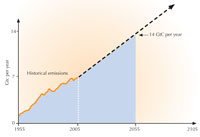
and predicted levels of
carbon emissions (modelled
in 2005). Click on image to
enlarge
Image adapted from the work
of Pacala and Socolow
This will give a level of carbon dioxide in the atmosphere three times higher than that observed before the Industrial Revolution. Our planet has not had such a high level (around 850 ppm) for 30 million years, and it is predicted to cause a rise in Earth’s average surface temperature of 1 to 5 °C.
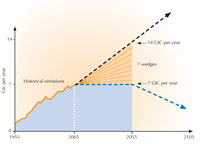
wedges could maintain
carbon emissions at current
levels. Click on image to
enlarge
Image adapted from the work
of Pacala and Socolow
Is this unavoidable? Pacala and Socolow believe not. They suggest that we try to maintain carbon emissions at their current levels of 7 GtC per year and because no one method will achieve this, they have devised the idea of stabilisation wedges.
A wedge represents an activity or technology that reduces carbon emissions to the atmosphere; the reduction starts at zero today and increases linearly until, in 50 years time, it accounts for a reduction in predicted emissions of 1 GtC per year (Figure 2).
Over 50 years, the cumulative total of one wedge is therefore a reduction in predicted emissions of 25 GtC. A combination of seven wedges would achieve Pacala and Socolow’s aim: annual emissions of 7 GtC in 2055 rather than the predicted 14 GtC.
Because the model assumes a starting year of 2005, there are now fewer than 50 years to achieve the reductions, but the concepts are just as valid.
How could we save a wedge?

image source: Flickr
- More efficient cars. It is predicted that in 2055, there will be 2 billion (2 x 109) cars in use, four times the number today. If they averaged 16 000 km per year (as they do today) but operated at 4.7 l per 100 km of fuel instead of 9.4 l per 100 km (the current value), this could save one wedge of carbon.
- Reduced car use: by 2055, assuming 2 billion cars and no improvement in car efficiency, one wedge could be saved if the distance travelled per year was halved, from 16 000 km to 8000 km.
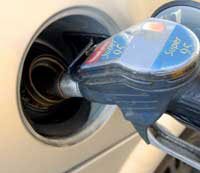
pixelio.de
Both of these options could save more than one wedge if the number of cars in use by 2055 has been over-predicted. For example, more use of telecommunication (such as web conferencing and home working) and public transport would reduce the number of cars needed.
- More efficient buildings: many savings can be made. For example, replacing all the world’s incandescent light bulbs with compact fluorescent lights would save ¼ wedge. Even larger savings are possible with heating and cooling. To save a whole wedge, we would need to reduce carbon emissions from buildings by 25%.
- Improved power plant efficiency: coal-powered plants currently operate at about 32% efficiency and are responsible for about 25% of all carbon emissions. Improving plant efficiency to 60%, e.g. with fuel cells or better turbines, would save half a wedge if the quantity of coal-based electricity were unchanged.
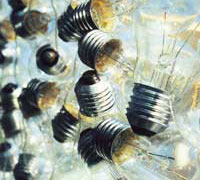
/ pixelio.de
- Decarbonisation of electricity and fuels: for example, per unit of electricity, carbon emissions from natural-gas power plants are half those of coal-based power plants. One wedge could be saved if, by 2055, 1400 GW that is currently produced from coal were instead produced from gas.
- Increased use of renewable, non-fossil, energy sources including nuclear fission, wind electricity, photovoltaic electricity and biofuels.

Newton -Syms; image
source: Flickr
- A wind-electricity wedge would require a wind farm with a combined land area the size of Germany.
- A photovoltaic electricity wedge would need an array of photovoltaic panels with a combined area about 12 times that of metropolitan London, UK.
- One wedge of first-generation biofuels would require planting an area the size of India with biofuel crops.
All these options are based on current technologies, and therefore some may provide even more savings as technology improves. There are also conservation options for saving wedges that do not involve modern technology:
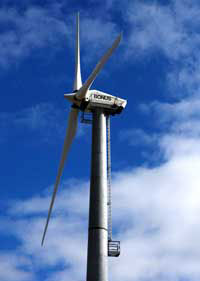
Meister / pixelio.de
- Deforestation: eliminating clear-cutting of primary tropical forest over the next 50 years would save half a wedge. A further half a wedge would be saved if 250 million hectares of tropical land were reforested, or 400 million hectares of temperate land (current areas of tropical and temperate forests are 1500 and 700 million hectares, respectively) over 50 years.
- Soil management: conversion of forest or natural grassland to cropland aerates the soil through annual tilling, accelerating the decomposition of stored carbon and releasing it back into the atmosphere. It is believed that, historically, 55 GtC (2 wedges worth) have been released in this way. Currently, of a total of 1600 million hectares of cropland worldwide, only 110 million hectares undergo conservation tilling, whereby the soil is not disrupted. Examples of conservation tilling include soil-erosion control, planting of cover crops, and drilling of seeds without ploughing. Conservation tilling of all croplands could save from a half to one whole wedge.
More vegetarianism and thus reduced levels of meat farming would also reduce carbon (and methane) emissions.
Classroom activities
Carbon dioxide emissions and the measures taken to reduce them will affect the young more than their teachers or the authors, so this is an important topic for schools. It could be used for a number of individual, group or class activities.
- Choose a carbon-saving activity or technology and either produce a poster or give a presentation to the rest of the class explaining how it works and how it could decrease atmospheric carbon.
- Investigate how you would save the requisite seven wedges. Which solutions would you use? What consequences would they have for people?
- If only three carbon-saving activities or technologies could be implemented, which would you choose and why?
- One carbon-reducing method could be to forbid cars to be driven by people under 24 years of age. Discuss the advantages and disadvantages.
- Identify the effects on ecosystems of any one of the carbon-saving technologies.
- Which carbon-saving solutions could be introduced at school and at home? Investigate the cost of powering your school by various methods (e.g. electricity, natural gas, butane, propane and fuel oil) and the savings made by any alternative-energy methods employed by your school.
- Should citizens of all countries be required to save carbon equally? Should developed and developing countries be treated differently?
- What do you think about the concept of stabilisation wedges? Is it sufficient to aim to keep carbon dioxide emissions at their current levels by 2055 or do we need to reduce them even further? Is that manageable? If so, how?
- Write a 250-word essay to your grandparents, explaining why the reduction of carbon is necessary and what they could do about it.
References
- Pacala S, Socolow R (2004) Stabilization wedges: solving the climate problem for the next 50 years with current technologies. Science 305(5686): 968-972. doi: 10.1126/science.1100103
- Socolow RH, Pacala SW (2006) A plan to keep carbon in check. Scientific American September 2006: 28-35. www.scientificamerican.com/article.cfm?id=a-plan-to-keep-carbon-in
Web References
- w1 – For further details about Stephen Pacala and Robert Socolow’s work, see the website of the Carbon Mitigation Initiative at Princeton University, USA: http://cmi.princeton.edu
- In particular, a free board game and supporting materials can be downloaded here: http://cmi.princeton.edu/wedges
Resources
- The Scientific American website offers a slide show about ‘The World’s 10 Largest Renewable Energy Projects’. See www.scientificamerican.com or use the direct link: http://tinyurl.com/3qr2mpc
- To read more about stabilisation wedges and introducing them into your life, see:
- Biello B (2007) 10 solutions for climate change: ten possibilities for staving off catastrophic climate change. Scientific American. See www.scientificamerican.com or use the direct link: http://tinyurl.com/3p9h22r
- Calculate your own carbon footprint on The Nature Conservancy website: www.nature.org/greenliving/carboncalculator
- or the website of Conservation International: www.conservation.org/act/live_green/carboncalc
- To introduce primary-school children to carbon dioxide, see:
- Rau M (2011) Fizzy fun: CO2 in primary school science. Science in School 20: 24-29. www.scienceinschool.org/2011/issue20/co2
- Find out more about the sustainable use of energy and how to teach it:
- Haubold B (2011) Review of Sustainable Energy – without the hot air. Science in School 20. www.scienceinschool.org/2011/issue20/sustain
Review
Anthropogenic carbon dioxide production and climate change are common topics in science and environmental curricula in Europe and beyond, so the novelty of this article is the proposed approach, inspired by the Carbon Mitigation Initiative at Princeton University, USAw1. Teachers can introduce their students to the concept of stabilisation wedges, ways to reduce carbon dioxide production with present-day technologies, with the help of the proposed activities or a board game. It could also motivate students (and their families) to save energy and reduce carbon dioxide production in everyday life.
This article could be used to address many topics: greenhouse effect and climate change, atmospheric chemistry, natural resources, energy production and management, ecology, active citizenship and many others. The links to many different subjects make this article a potential starting point for interdisciplinary activities.
Giulia Realdon, Italy





